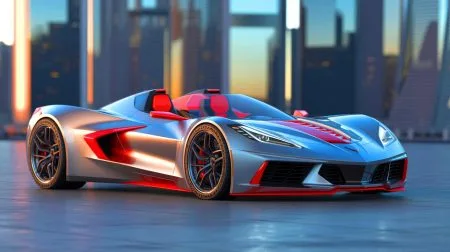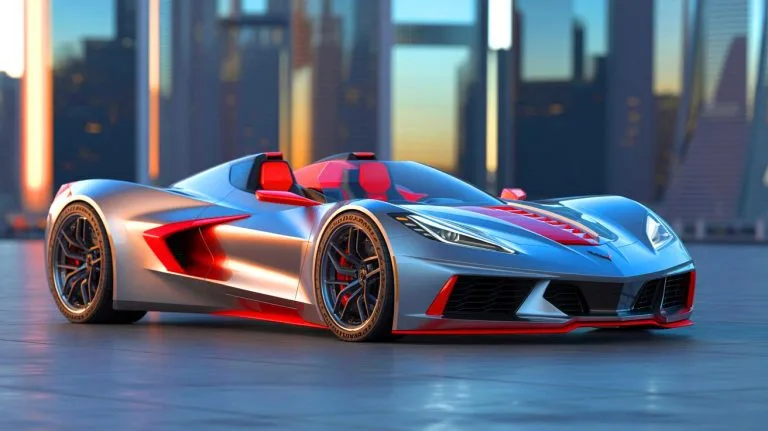| IN A NUTSHELL |
|
General Motors (GM) has once again captured the automotive world’s attention with its latest Corvette concept, a futuristic design from its Advanced Design studios in Pasadena. This concept follows closely on the heels of an earlier reveal, a pristine white Corvette with gull-wing doors. The new iteration showcases bold red accents, a detachable cockpit, and a single-piece canopy with front hinges. These features allow the vehicle to transform seamlessly from a closed sports coupe to an open, ultralight convertible. While GM has stated that it has “no direct production intent,” the concept offers a tantalizing glimpse into the potential future of Corvette design.
Innovative Design Features
The latest Corvette concept is marked by its innovative design elements, which pay homage to the brand’s storied past while pushing the boundaries of automotive design. The vehicle features a detachable cockpit and a single-piece canopy with front hinges, enabling quick transformation into a convertible. The bold red accenting gives it a striking visual appeal, reminiscent of the Jaguar C-X75 with its short rear end and distinctive rocker panels. The concept measures 182.5 inches in length, comparable to the current C8 model, but is significantly lower in height, promising a more spacious cabin thanks to its unique T-shaped prismatic battery design.
This battery configuration is a departure from the traditional skateboard-style underfloor unit, allowing for enhanced airflow through the chassis. The design also incorporates large wheels—21 inches at the front and 22 inches at the back—adding to its aggressive stance. The concept’s wheelbase of 109 inches provides an additional 1.8 inches of interior room compared to previous generations, highlighting GM’s focus on combining performance with comfort.
Advanced Aerodynamics and Technology
The Corvette concept features advanced aerodynamics, drawing inspiration from Formula 1 designs. The windshield design, reminiscent of Koenigsegg’s philosophy, is positioned above the axle line, contributing to the car’s sleek profile. At the rear, an enormous diffuser works to generate downforce without the need for a traditional rear wing. Channels carved through the body allow air to flow under the nose to the diffuser, enhancing its aerodynamic efficiency. An active rear spoiler further aids performance by acting as an air brake when needed.
Inside, the concept car emphasizes minimalism, with most controls integrated into the touchscreen embedded in the steering wheel hub. This steering mechanism resembles a yoke more than a traditional wheel, reinforcing the futuristic theme. An augmented-reality head-up display projects critical driving information directly into the driver’s line of sight, eliminating the need for larger screens. The interior is completed with fixed bucket seats attached to a carbon tub, emphasizing the car’s performance-oriented nature.
Electric Power and Performance Potential
As an electric vehicle, the Corvette concept represents GM’s exploration of future powertrain possibilities, although specific performance details remain under wraps. The concept’s T-shaped prismatic battery is expected to contribute to improved airflow and handling dynamics, showcasing the potential benefits of electric power in a high-performance sports car. Despite the lack of immediate production plans, the concept may signal GM’s long-term vision for an electric Corvette, although current rumors suggest that an all-electric version may not arrive soon.
The design serves as a testament to GM’s commitment to innovation and sustainability, aligning with broader industry trends toward electrification. However, the company’s cautious approach in confirming production plans reflects the challenges and uncertainties associated with transitioning iconic performance brands to electric power.
Supercar maintenance: Tips for keeping your ride in top shape
The Future of Corvette Design
While GM has made it clear that the concept has “no direct production intent,” it offers valuable insights into the possible design directions for future Corvettes. The concept’s sporty and sculpted aesthetics, combined with advanced technologies, suggest a bold new era for the brand. Enthusiasts and industry observers alike will be watching closely for the unveiling of the third and final design in this series, anticipated by year’s end.
This ongoing exploration by GM raises questions about the future of sports cars in an increasingly electric automotive landscape. As the industry evolves, the challenge will be to balance the demands of performance enthusiasts with the imperatives of sustainability and innovation. The Corvette concepts are a step toward understanding how these elements can coexist, but whether they will lead to a production model remains an open question.
As General Motors continues to push the envelope with its Corvette concepts, the automotive world is left to ponder the implications for the future of performance cars. Will the iconic Corvette eventually transition to an all-electric lineup, or will it find a way to integrate advanced technology while preserving its traditional appeal? The answer may well shape the direction of sports car design in the coming years.
Did you like it? 4.4/5 (25)






Wow, a detachable cockpit? That’s some James Bond stuff right there! 😎
Wow, a detachable cockpit? Are you sure it’s not a Transformer in disguise? 🤖